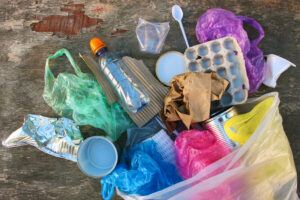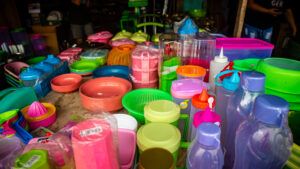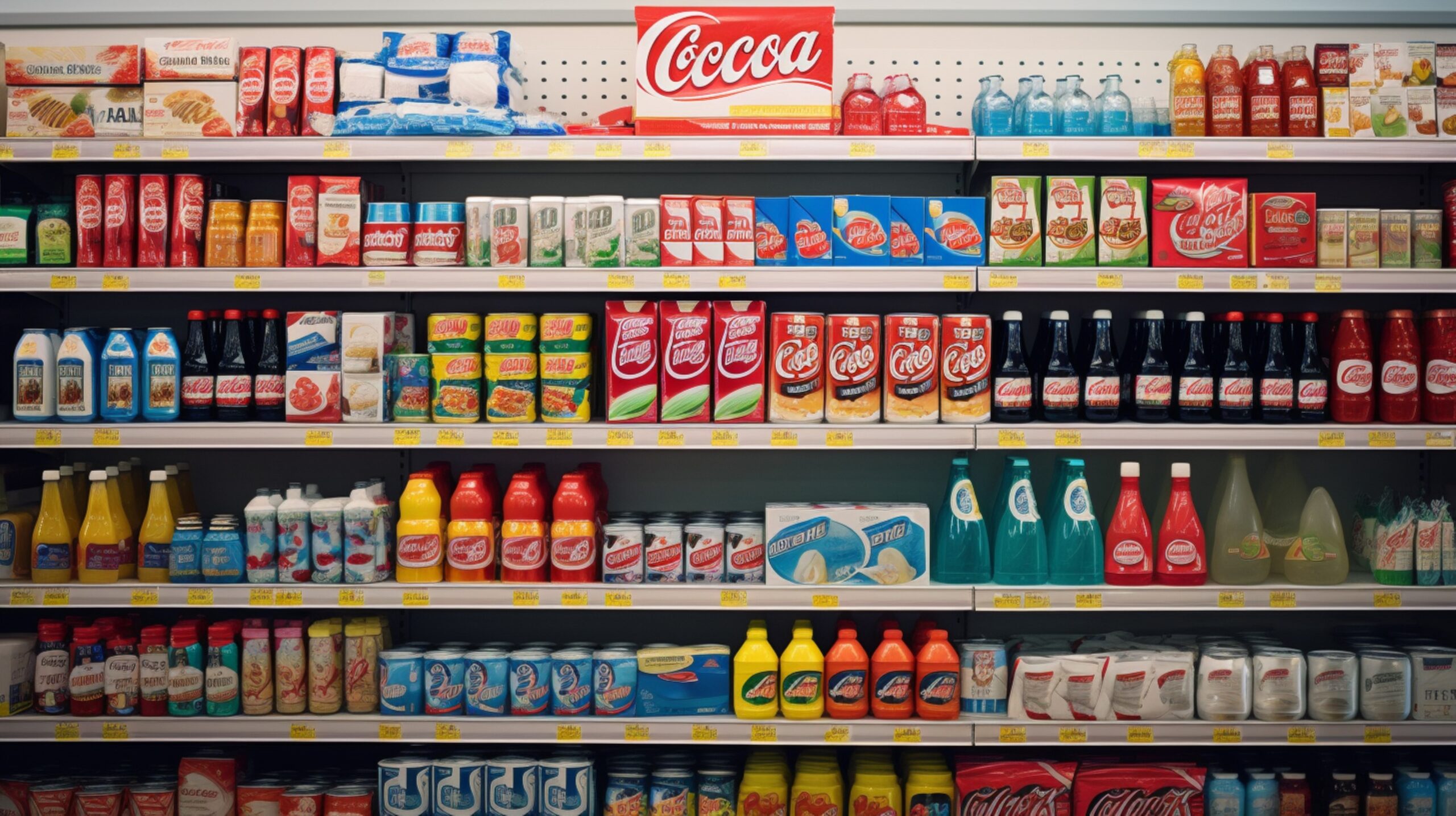The Plastics Dilemma
Plastic is everywhere:
 Reducing your plastic use might feel like a massive challenge, especially when we’re constantly surrounded by plastic in our everyday lives. From food packaging to bottles and bags, it’s hard to ignore the amount of plastic that ends up in the trash after just a couple of uses. Feeling guilty about it is normal—it’s a lot of waste! But we here at Simply Sustainable Lifestyle are committed to taking the fear out of living a sustainable lifestyle. Guilt can have the effect of paralyzing a person, making them just want to look the other way.
Reducing your plastic use might feel like a massive challenge, especially when we’re constantly surrounded by plastic in our everyday lives. From food packaging to bottles and bags, it’s hard to ignore the amount of plastic that ends up in the trash after just a couple of uses. Feeling guilty about it is normal—it’s a lot of waste! But we here at Simply Sustainable Lifestyle are committed to taking the fear out of living a sustainable lifestyle. Guilt can have the effect of paralyzing a person, making them just want to look the other way.
So let’s examine how we can take steps to move forward and feel better about our efforts to live sustainably while still maintaining a lifestyle we are comfortable with.
Understanding Single-Use Plastics

Did you know that the United States produced more plastic trash than any other country from 2010 to 2016? That’s an unbelievable amount—millions and millions of tons of plastic waste, almost reaching 300 pounds for each person annually. Shocking, right?
Single-use plastics are items made primarily of plastic designed to be used once and then disposed of. They are prevalent in our daily lives and contribute significantly to plastic pollution due to their short lifespan. These items are often used for convenience but have a detrimental impact on the environment.

Common examples of single-use plastics include:
- Plastic Bags: Thin, lightweight bags used for carrying groceries, shopping, or packaging goods.
- Straws: Small plastic tubes used for drinking beverages.
- Disposable Cutlery: Plastic forks, knives, and spoons used for takeout or quick meals.
- Plastic Bottles: Single-serving beverage containers made of plastic.
- Packaging Wrappers: Plastic wraps are used to package food items like sandwiches, fruits, or vegetables.
- Coffee Stirrers: Small plastic sticks used to stir coffee or tea.
- Takeout Food Containers: Plastic containers used for takeout meals.
- Cups and Lids: Disposable plastic cups and lids used for drinks.
- Cotton Swabs: Often made with plastic stems and used for hygiene purposes.
- Plastic Plates and Bowls: Disposable tableware made of plastic for quick meals or events.
- Personal care items: Shampoos, deodorants, hairsprays, and other personal care items are packaged in plastic for the most part.
- Miscellaneous items of all kinds: Children’s toys, items for the pool and outdoor living, accessories for the car, and oh so many items that make like more convenient.
These items are typically used briefly and then discarded, leading to a significant accumulation of plastic waste in landfills, oceans, and other natural environments. Their disposal poses a severe threat to wildlife, ecosystems, and human health due to their slow degradation and the release of harmful chemicals as they break down.

Single-use plastics have become ubiquitous due to their convenience, affordability, and versatility in various industries. Several factors have contributed to their widespread use:
- Convenience: Single-use plastics offer convenience for consumers. They are lightweight, easily disposable, and often come in practical sizes for on-the-go use.
- Cost-Effectiveness: Producing single-use plastics is generally inexpensive compared to alternative materials. This cost efficiency has led to their widespread adoption by manufacturers and businesses.
- Versatility: Plastics can be molded into various shapes and forms, making them suitable for a wide range of products. This versatility has encouraged their use in packaging, food service, healthcare, and other industries.
- Durability: Plastics are durable and can withstand various conditions, including moisture and temperature changes. This durability makes them attractive for packaging and storage purposes.
- Marketing and Advertising: The convenience and low cost of single-use plastics have been promoted through marketing campaigns, encouraging their use and perpetuating a disposable culture.
- Consumer Habits: The rise of fast-paced lifestyles and a culture of convenience has led to increased demand for single-use items. Busy schedules and a desire for quick, on-the-go solutions have fueled the popularity of these products.
- Lack of Alternatives: In some cases, viable alternatives to single-use plastics have been limited or more expensive, making it challenging for consumers and industries to switch to more sustainable options.
The combination of these factors has contributed to the widespread use and acceptance of single-use plastics, leading to their proliferation in our daily lives and the subsequent environmental challenges associated with their disposal.
 The life cycle of single-use plastics and their environmental footprint
The life cycle of single-use plastics and their environmental footprint
Unfortunately, only about 9% of all that plastic gets recycled in the U.S. The rest? It finds its way into landfills, incinerators, and even into our rivers and oceans. Once it’s there, it sticks around for hundreds of years. It’s pretty scary to think about.
The life cycle of single-use plastics involves several stages, each contributing to their environmental footprint:
- Extraction and Production: The process starts with extracting raw materials, primarily fossil fuels like oil and natural gas, which are used to create plastic polymers. These materials undergo refining and chemical processes to form the base for manufacturing plastic products.
- Manufacturing: Plastic polymers are molded, extruded, or shaped into various single-use products, such as bottles, bags, packaging, and utensils. This stage consumes energy, water, and resources.
- Use: Single-use plastics are utilized for short periods, often just once, for tasks like packaging goods, storing food, or as disposable items (straws, cutlery, cups). Despite their short lifespan, these plastics contribute to convenience in our daily lives.
- Disposal: Once discarded, single-use plastics go through various disposal methods:
- Landfill: A significant portion of these plastics ends up in landfills, where they may take centuries or more to decompose, releasing greenhouse gases and leaching harmful chemicals into the soil and water.
- Incineration: Some plastics are incinerated, producing emissions and contributing to air pollution.
- Litter: Improperly disposed of plastics end up as litter, polluting landscapes, water bodies, and harming wildlife. They can break down into microplastics, entering the food chain and ecosystems.
- Microplastics and Environmental Impact: Over time, plastics degrade into smaller particles known as microplastics due to weathering and exposure to sunlight. Microplastics contaminate soil, water, and air, posing threats to aquatic life, wildlife, and potentially human health through the food chain.
- Longevity: Single-use plastics, designed for short-term convenience, have an extensive environmental footprint due to their persistence in the environment, often lasting hundreds of years without fully degrading.
Reducing the environmental impact of single-use plastics involves strategies at various stages, including reducing consumption, promoting recycling and proper disposal, investing in alternative materials, and fostering a circular economy to minimize waste and resource usage.
What can WE do about this huge problem?
 A lot of experts have some good ideas, but it’s clear that every little action counts. Reading the basic information we have provided in this article is just the tip of the proverbial iceberg of the issue. What we aim to do here at Simply Sustainable Lifestyle is to bring big issues down to the common person. We want to offer solutions that will make change from a grassroots perspective. The bigger picture is something we may address by staying informed of the research, the science, the laws, the politics, and the larger solutions being discovered. We use our vote to elect officials who care about the environment and support organizations and businesses that are actively offering solutions. Here are some links that may help you see how you fit into the bigger picture with your support.
A lot of experts have some good ideas, but it’s clear that every little action counts. Reading the basic information we have provided in this article is just the tip of the proverbial iceberg of the issue. What we aim to do here at Simply Sustainable Lifestyle is to bring big issues down to the common person. We want to offer solutions that will make change from a grassroots perspective. The bigger picture is something we may address by staying informed of the research, the science, the laws, the politics, and the larger solutions being discovered. We use our vote to elect officials who care about the environment and support organizations and businesses that are actively offering solutions. Here are some links that may help you see how you fit into the bigger picture with your support.
For now, let’s take a look at some simple ways to start making a difference by doing an audit of your plastic use and examining what solutions we might employ to reduce our plastic use and properly recycle what we can.
Review Your Plastic Use:
- Start Gathering: Collect all the plastic stuff you use in a regular week—things like packages, bottles, bags, and utensils.
- Track Your Usage: Make notes on your daily plastic use to see where you use the most. It’s easy—just jot it down on your phone or a notepad.
- Sort and Study: Divide items into single-use, recyclable, and non-recyclable to understand how much you’re using.
- Find Alternatives: Look for substitutes for high-use plastic, like switching plastic bags for reusable ones. It’s a fun research project and could involve your family or housemates for more ideas and cooperation.
- Check Recycling: Make sure you’re recycling correctly by following local guidelines. Your garbage hauler might have an online resource for details.
- Think About Purchases: Reflect on what you buy and aim for products with less plastic packaging. Take your time while shopping and consider sustainability, and recycling options, as well as your needs, price, and convenience.
- Set Targets: Start with achievable goals to lessen your plastic use. Little changes can add up and lead to more significant shifts in habits.
- Track Progress: Keep an eye on how you’re doing and tweak things as needed. Review your notes and goals occasionally to see your progress toward less plastic.
- Share Your Journey: Discuss your journey with friends and family to inspire them to cut down on plastic too. It’s not about boasting, just sharing your experience to encourage others to join in. The more, the merrier in this grassroots effort!

Here Are Some Simple Plastic-Free Swaps (click the links to find them online):
- No More Plastic Water Bottles: Carry a refillable stainless-steel bottle for water and a reusable thermos for coffee.
- Opt for Cardboard and Glass: Choose products in cardboard boxes or glass jars over plastic packaging at the store.
- Lose the Straw: Avoid using plastic straws and switch to reusable stainless steel or compostable paper alternatives.
- Pack Lunch in Glass or Metal Containers: Replace Ziploc bags with glass or metal lunch containers or your lunch. You can also replace regular zip lock bags with reusable silicone bags or bees wax wrappers.
- Avoid Micro-Plastic Facewash: Check product labels for ingredients like polypropylene or polyethylene and choose biodegradable alternatives.
- Switch from Plastic Razors: Consider razors with replaceable blades or electric razors.
- Use Cloth Diapers: Consider using reusable cloth diapers instead of disposable ones for babies. A diaper service if you can afford it will usually state their sustainability practices. With the busy lifestyles of working parents, this service is a great way to care for the planet.
- Use your own coffee cup: If you like to get coffee from a coffee shop either stay and drink from one of their cups or bring your own to have filled. Worst case say no to the plastic top. Just don’t have them fill to the brim so you don’t need to spill.
- Collect your non recyclable items: Once a month or so check with Teracyle to see if the products have a free recycle program. Teracycle has a mission to eliminate the idea of waste. Learn more about how TerraCycle is working to eliminate the idea of waste. You can also use Ridwell a company that will pick up items that cannot go into your regular recycling bin. Check them out here to see if they pick up in your area and pricing.
- Discover a non plastic alternative: Be on the look out of products that will accomplish your grooming, cleaning and general use goals that are available in bulk, not wrapped (like bar shampoos) or wrapped in recyleable materials.
- Avoid stores that wrap everything in plastic: Costco and Trader Joe’s are among our top shopping destinations. However, as we wander through their aisles, we notice an abundance of products needlessly wrapped in plastic. This situation challenges our commitment to sustainability, prompting us to either rethink our shopping practices or meticulously select items packaged in glass, cardboard, or without plastic wrapping.
Taking small steps can make a big difference in cutting down plastic waste. Sometimes, beig sustainable means swapping a product wrapped in plastic for a more eco-friendly option. If there are stores you avoid because of excessive plastic packaging, you might find similar products elsewhere with better packaging.
Living without plastic isn’t an overnight shift. Yet, the more individuals strive for a plastic-free life, the stronger the message to manufacturers and stores becomes. Here at Simply Sustainable Lifestyle, we’re dedicated to reducing our daily plastic use. With ongoing efforts, we aim for saying no to plastic to become easier, enabling us to take more significant strides forward.
What else can you do to fight plastic pollution?
Share your ideas and inspire others to join in! We welcome and encourage comments from our readers, the more engagement in the task of creating a sustainable lifestyle the better.
We‘d love to hear feedback on our ideas to reduce plastic consumption or field questions you may have about our reccommendations. Please leave your comments below and while your are at it sign up for our email list so you will recive notification of new helpful articles we post.
We use Affiliate Links to sustain Simply Sustainable Lifestyle’s writing and research. We curate goods and services that enrich the simple and sustainable lifestyle experience. Your feedback on products and services, whether great or falling short, is invaluable in aligning recommendations with the blog’s focus.


